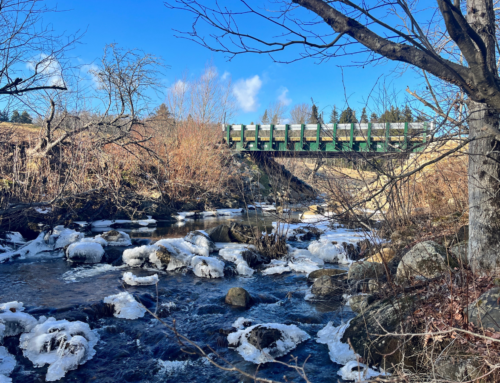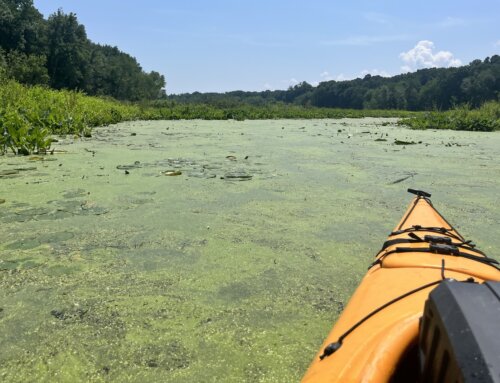When the Connecticut River empties into Long Island Sound far away to our south, it impacts the water quality of the Sound. Although the Connecticut River provides 70% of the fresh water that enters the Sound and water quality is better at the mouth of the river than in western reaches toward the population centers, there are significant problems with low dissolved oxygen levels throughout the Sound. The thread connecting our river uses here and low oxygen levels there in the Sound is nitrogen.
Nitrogen is an element found as a gas at normal temperature and pressure at the surface of the earth. Along with being 78% of the air we breathe, nitrogen is found naturally in soil and water. Nitrogen is an essential ingredient for our bodies and for plant photosynthesis and is present in all living organisms in the form of proteins, nucleic acids and other molecules that are the building blocks of life.
Nitrogen is not found naturally as a single atom but as a molecule consisting of two atoms of nitrogen. The bond between the two atoms is unusually strong, making nitrogen one of the least reactive elements, so plants cannot use nitrogen in its molecular form. In order for it to be useful to plants it must be “fixed.” Fixing nitrogen takes a process, natural or otherwise that breaks the bonds of elemental nitrogen and forms useful molecules of nitrite, nitrate or ammonium. We can thank legumes, all mammals, lightning, industrial processes and bacteria for fixing nitrogen.
Nitrogen is a large component of animal waste, including ours in the form of urea, uric acid and ammonium compounds. Most of what we eat contains nitrogen and our internal bacteria convert what we eat into energy for our bodies and waste that has high levels of nitrogen. Our waste-water treatment facilities fix the nitrogen and then discharge it into receiving waters. Other sources of fixed nitrogen that makes it way to water come from manufactured fertilizers and animal wastes that we broadcast apply in large amounts on the land to stimulate plant growth. If runoff after rain moves sediment into a waterbody, it is moving nitrogen too.
Plant biology is another link between the Connecticut and Long Island Sound. Plants usually face a limiting nutrient in their normal habitats. In some watersheds like Lake Champlain the limiting nutrient is phosphorous. Plant growth including algae would be kept in check by what phosphorous is available naturally. Lake Champlain is considered an impaired waterbody because high levels of phosphorous are discharged to the water. That excess phosphorous causes plant growth to explode, including algae. Some of the algae blooms are toxic, and when the plants die and settle to the bottom they require oxygen to complete decomposition.
The limiting nutrient in the Connecticut River watershed is nitrogen. When nitrogen is added to our waters the expected surge affects aquatic plant growth all the way downriver and into Long Island Sound. The Sound is considered an impaired waterbody due to high levels of nitrogen being discharged into it, leading to excessive plant growth and, as you would expect, the plant growth causes excessive oxygen demand when the plants die and decompose.
The bacteria busy decomposing the plants are doing what comes naturally, so decomposition is not the problem. The problem lies in the excessive plant growth because bacteria pull available dissolved oxygen out of the water to complete the process. Too much plant growth, too many dead plants, too much oxygen taken from the water during decomposition – all these lead to a condition called anoxia, the lack of sufficient levels of oxygen to support healthy aquatic life.
Along with a biological connection between here and there, there is a legal connection as well. The Sound has an approved Total Daily Maximum Load (TMDL) plan. TMDL is government speak for a cleanup plan under the provisions of the federal Clean Water Act that requires any point or non point discharge source, regardless of how distant it is from the Sound, to reduce nitrogen loading, so that means we, even in the upper valley, must do our part.
VT and NH contribute significant amounts of nitrogen to the Connecticut River through our waste water treatment plants, agricultural fertilizing practices and stormwater run off from roads, building and parking lots. The Environmental Protection Agency recently objected to a discharge permit for a municipal waste water treatment plant in the upper river because the level of nitrogen allowed to be discharged increased in the new permit above the previous permit limits. Although this is a first of its kind objection, the EPA notice is in keeping with provisions of the cleanup plan to reduce all nitrogen sources that contribute to impairment of the Sound. There may be other EPA objections in the future that will affect Connecticut River discharge permits and agricultural practices. Stay tuned.
David Deen is River Steward for the Connecticut River Watershed Council. CRC has been a protector of the Connecticut River for more than half a century.







